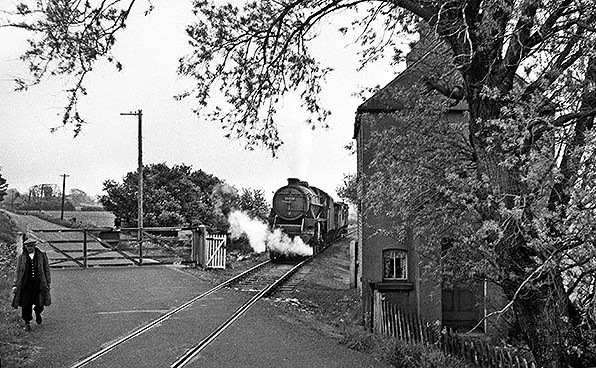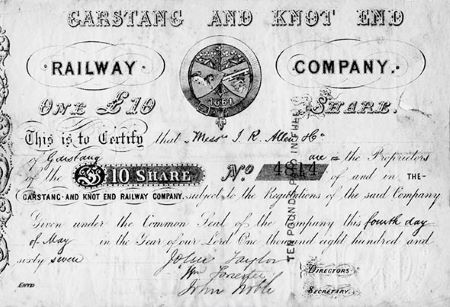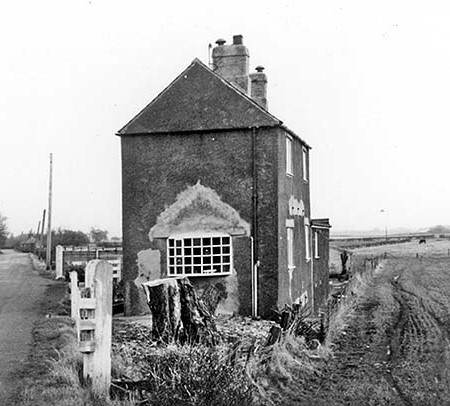
A view looking east away from the site of Cogie Hill Halt at the level crossing and crossing keepers cottage in 1958. Photo from the John Phillips collection.
In the early years of the 19th Century the area around Cogie Hill had been an unworked expanse of moss but improvements had made it into productive agricultural land. In December 1863 the Garstang & Knot (sic) End Railway (G&KER) company was formed to create an 11½ mile line that would unlock the potential of the land in the area. In their early publications grand ideas were put forward that included their line becoming part of an alternative route to the north-east of England. The idea that Knott End might be developed as a major port to rival nearby Fleetwood was also discussed. These statements alarmed the bigger railway companies who objected to the proposals, which incurred a great deal of cost for the G&KER. In the end they had to modify their aspirations and submit their bill as very much a local railway that would serve only the local area. The railway was authorised on 30 June 1864.
From the start there were financial difficulties. The Parliamentary Act had authorised £60,000 in share capital, but the G&KER was unable to raise the subscriptions required. By December 1867 only half a mile of line had been created and it became clear that creating the route to Knott End was not going to be possible so the plans for the route west of Pilling were abandoned.
 The single track line, of only 7 miles between the LNWR Garstang station (which started to be referred to as the ‘Junction’ station) and Pilling, opened on 5 December 1870. There were intermediate stations at Garstang (the town) and Nateby (then called Winmarleigh). The line had cost £106,715. It had been the intention of the G&KER to build the station that eventually became Nateby at Cogie Hill but during the early days of the construction of the line, following representations from the local landowners and farmers, a decision was made to build the station further east. The single track line, of only 7 miles between the LNWR Garstang station (which started to be referred to as the ‘Junction’ station) and Pilling, opened on 5 December 1870. There were intermediate stations at Garstang (the town) and Nateby (then called Winmarleigh). The line had cost £106,715. It had been the intention of the G&KER to build the station that eventually became Nateby at Cogie Hill but during the early days of the construction of the line, following representations from the local landowners and farmers, a decision was made to build the station further east.
At Cogie Hill Island Lane crossed over the railway by means of a level crossing. A crossing keeper’s cottage (one of six situated along the line) was provided on the east side of the crossing and on the south side of the line.
To operate the train services the G&KER acquired an 0-4-2 saddle tank named ‘Hebe’ through a hire purchase arrangement. On 12 October 1870 a group of debenture holders had formed the Garstang Rolling Stock Company (GRSC) and they purchased four passenger coaches.
The G&KER operated mixed passenger/goods trains and the busiest section of the line was that which stretched between Garstang (Town) and Garstang (Junction). There were nine trains in each direction on that stretch of the line Monday-to-Saturday. Through Cogie Hill, on the Garstang Town – Pilling section of line, there were only two trains in each direction (three on market days). Trains would pick up and drop off passengers at points along the line other than the formal stations and Cogie Hill was one of the stopping points.There were no passenger facilities at Cogie Hill and the exact point at which the trains stopped is not known. A platform and waiting shelter were erected to the west of the level crossing (on the south side of the line) shortly after 1893 and it is possible that this was the spot at which the trains had always stopped. Equally they may have stopped by the crossing keeper’s cottage which is marked on the 1915 1inch scale map as the halt.
 Having only one locomotive caused problems and when ‘Hebe’ needed major repairs in March 1872 the line had to close for two days. On 11 March 1872 the passenger service had to be suspended and although it restarted for a period further problems brought an end to locomotive haulage on 29 March 1872. Occasional goods services were operated after this date using horses for traction. Having only one locomotive caused problems and when ‘Hebe’ needed major repairs in March 1872 the line had to close for two days. On 11 March 1872 the passenger service had to be suspended and although it restarted for a period further problems brought an end to locomotive haulage on 29 March 1872. Occasional goods services were operated after this date using horses for traction.
This dire state of affairs was resolved in the early months of 1875 when the debenture holders purchased an 0-4-0T locomotive named ‘Union’. On 23 February 1875 goods services resumed followed by passenger services on 17 May 1875. There was a basic passenger service of five trains in each direction with variations on Thursdays and Saturdays to accommodate those wishing to travel to and from the market at Garstang. However, almost all the trains now ran between Garstang (Junction) and Pilling, with stops, as required at Cogie Hill and Cockerham Crossing. In December 1875 a further engine was purchased. It was an 0-6-0ST named ‘Farmers Friend’ and it went into service in 1876. It had a distinct high pitched whistle and locals began to call it the ‘Pilling Pig’. That name stuck and began to be applied (unofficially) to subsequent engines that operated on the line.
The G&KER continued to struggle financially and in 1878 the railway was placed in the hands of a receiver as it was unable to meet its financial obligations.
In 1881 the LNWR had renamed their Garstang station as Garstang & Catterall.
In August 1889 a Moss Litter Works was opened at Cogie Hill by the Fylde Peat Moss Litter Co Ltd. The works were located to the west of the level crossing on the north side of the line and were provided with a private siding that had a facing connection for Pilling bound trains. It is likely that this was put in fairly soon after the works opened in 1889. The works were not a financial success and had gone out of business by 1897.
In April 1893 an agreement was made in respect of ground rent arrears due to the beneficiaries of Lord Winmarleigh’s estate. The beneficiaries used the settlement as an opportunity to impose various terms and conditions on the railway for the benefit to the tenants of the Winmarleigh estate. These were as follows: the railway was to use its best endeavours to provide a passenger service at Cogie Hill and to stop trains there on Thursdays and Saturdays, Thursday being market day in Garstang. The railway had in fact been stopping trains at Cogie Hill crossing since the opening of the line but the practice was now confirmed in a formal agreement. In addition to this, the G&KER was to build a platform and a passenger shelter at Cogie Hill for a sum not exceeding £15. The platform and shelter were to the west of the level crossing on the south side of the line. Access was via a footpath which ran from Island Lane along the easterly edge of the plantation adjacent to Cogie Hill Farm.
The December 1895 timetable showed Cogie Hill as having four trains in each direction Thursdays and Saturdays only.
 In 1894 consideration was given to continuing the line to Knott End. As the G&KER could not raise the capital required, on 12 August 1898, Parliamentary authority was obtained for the Knott End Railway (KER) to extend the line from Pilling to Knott End. As things turned out the new company had just as much difficulty in raising capital which was made worse due to a legal wrangle with their contractor. In the end it took them ten years to build a 4½ mile length of railway. Having two companies for an 11½ mile railway was not practical so on 1 July 1908 the KER bought the G&KER for £44,690. Passenger services began to serve Knott End on 30 July 1908. There was one intermediate station on the new section of line. After the extension to Knott End was opened in 1908, the service at Cogie Hill was improved slightly with an additional two trains on Fridays. In 1894 consideration was given to continuing the line to Knott End. As the G&KER could not raise the capital required, on 12 August 1898, Parliamentary authority was obtained for the Knott End Railway (KER) to extend the line from Pilling to Knott End. As things turned out the new company had just as much difficulty in raising capital which was made worse due to a legal wrangle with their contractor. In the end it took them ten years to build a 4½ mile length of railway. Having two companies for an 11½ mile railway was not practical so on 1 July 1908 the KER bought the G&KER for £44,690. Passenger services began to serve Knott End on 30 July 1908. There was one intermediate station on the new section of line. After the extension to Knott End was opened in 1908, the service at Cogie Hill was improved slightly with an additional two trains on Fridays.
The fortunes of the line improved in 1911 when the United Alkali Company opened a branch railway siding 1½ miles long near Knott End. By 1913 5,032 tons of salt were being carried and by 1920 the total had reached 53,894 tons. The United Alkali works also required considerable volumes of coal and in 1913 the KER transported 7,970 tons which rose to 13,678 tons in 1920.
A great deal of effort was made by the KER to promote Knott End as a holiday and day trip location. On busy Sundays during the summer period trains were run to cater for the leisure traveller. In 1913 the KER carried 91,918 passengers.
In 1913 A Dutch national, Norbert Engelen, was sent to Cogie Hill by the Midland Moss Litter Co. to reopen the peat workings on the moss and recommence moss litter production at the works. In August 1913, the KER wrote to the Board of Trade in London explaining that the siding serving the moss litter works had been closed for the last 15 years and that following the re-commencement of operations, it was now about to be re-opened. Access to the siding had originally been controlled by a train staff locking arrangement which had, in the previous year, been taken up for use on another part of the line. The railway went on to explain that a new staff locking arrangement had been fitted and they wished to know if it was necessary for the Board to inspect the new installation. Apparently, the Board thought it was, and Colonel Druitt was duly dispatched from Whitehall to Cogie Hill to carry out the inspection. In his subsequent report the Colonel describes the siding as follows:
“The siding connection has points facing to down trains on the single line, which are worked from a single lever ground frame controlled by the electric train staff for the section Pilling-Nateby”.
The Colonel deemed the interlocking and other arrangements satisfactory and recommended that the BOT sanction the use of the siding. As this memo was dated 5th December 1913 some four months after the original enquiry from the railway, it seems likely that the siding had been in use for some time prior to that date.
In the 1920 a daily bus service between Preston and Garstang was introduced and at a stroke it reduced through bookings between Garstang and Preston by 50%. The number of passengers carried on the line slumped from 112,000 in 1920 to 77,579 in 1922. As a means of countering this competition in the summer of 1920 the KER line hired a steam railmotor from the LNWR. The railmotor enabled the KER to cut expenditure and to provide a more flexible passenger service. At first the railmotor was used in addition to the locomotive hauled service during the summer season and for all passenger services in the winter period.

On 1 July 1923 the KER was absorbed into the London Midland & Scottish Railway (LMS). It was the smallest of the companies that was grouped into that organisation.
Under the LMS most of the passenger services continued to be operated by the railmotor.
During the 1920s there was a decline in both passenger numbers and in goods tonnage brought about by ever increasing competition from road transport. On 31 March 1930 the LMS withdrew the passenger service from the line and Cogie Hill was closed completely. The last LMS working timetable that showed a passenger service, which came into effect from 23rd September 1929, showed six up and five down passenger services. All bar the first down service which departed from Garstang Town for Knott End at 7.15 were worked by the railmotor.
The Moss Litter works closed in November 1931, following difficulties with the drainage of the workings out on the moss. The siding would have fallen into disuse at this time.
The line remained open for goods and passed to British Railways (BR) on 1 January 1948. On 13 November 1950 BR closed the 1908 KER section of the line between Pilling and Knott End. The section of line through Cogie Hill (between Garstang Town and Pilling) closed on 31 July 1963 and the track was lifted a couple of years later.
With special thanks to Dave Richardson author of The Pilling Pig - A History of the Garstang & Knott End Railway |

 Home
Page
Home
Page

 Home
Page
Home
Page